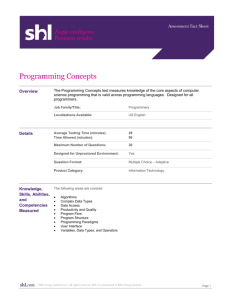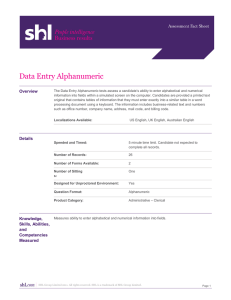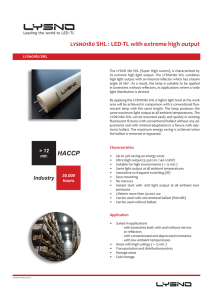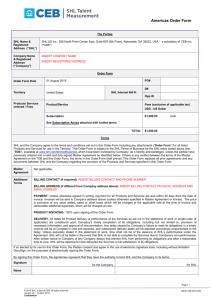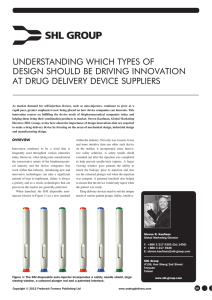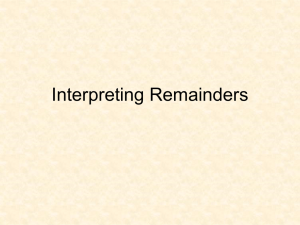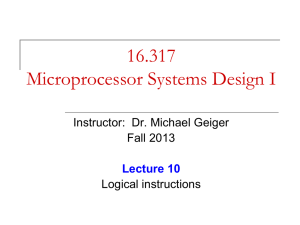Iterative Integer Division Techniques
advertisement
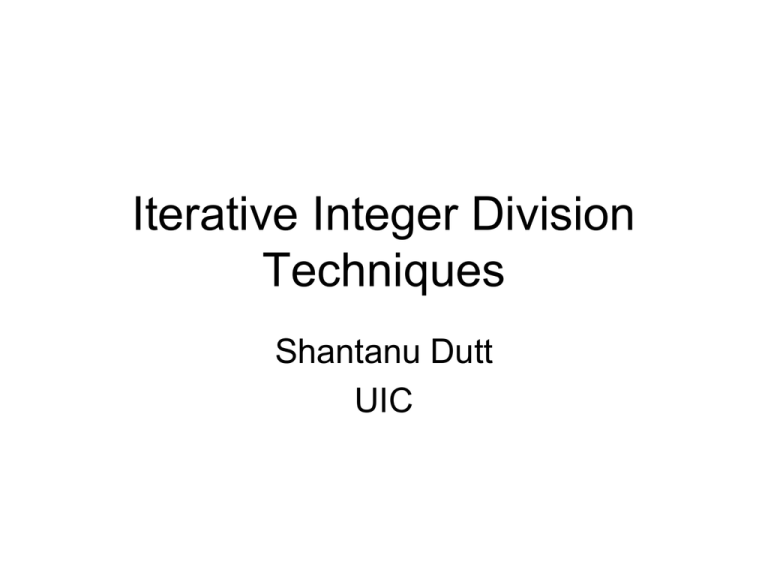
Iterative Integer Division Techniques Shantanu Dutt UIC Division – Basics • Radix r division is essentially a trial-and-error process, in which the next quotient bit is chosen from 0, …, r-1 • SHR-Divisor Method: Start subtraction of V from left most position of D, considering as many digits of D as there are in the V (ignoring leading 0’s). After subtraction, consider the next lower digit of D (i.e., in the “partial remainder”), and align D*(current Q digit) so that LS digits align, and subtract from the PR from that digit to its MS non-0 digit. This is almost equivalent to a SHR V for next subtraction every iteration. 088 = Q V=4 353 = D -0 353 - 32 033 - 32 001 = R • Binary division is much simpler, since the next quotient bit is either a 0 or 1 depending on whether the partial remainder is less than or greater than/equal to the divisor, respectively • Integer division: Given 2 integers D the dividend and V the divisor, we want to obtain an integer quotient Q and an integer remainder R, s.t. D = V.Q + R, R < V • Integer–FP division: Given 2 integers D the dividend and V the divisor, we want to obtain a floating-point (FP) or real quotient s.t. D ~ V.Q Division – SHL-Partial-Remainder Method • Instead of shifting the divisor right by 1 bit, the partial remainder can be shifted left by one bit (in non-binary case, if the current Q bit is non-zero) 088 = Q V=4 353 = D -0 353 - 32 SHL: 033 330 - 32 0111 = Q V = 100 SHL: SHL: 01 = R SHL: 011101 = D - 000 011101 011101 - 100 01101 01101 - 100 0101 0101 - 100 001 = R • If D is n bits and V is k bits (ignoring leading 0’s), perform n-k+1 iterations of the SHL & subtract process • • • • Division – Handling V with leading 0’s Some higher order bits of an n-bit V are 0’s One of the main requisites of correct division by repeated subtraction is that the portion of D (in general the partial remainder) from which V is being subtracted be < 2.V, since the Q bit can only be 0 or 1 Note that for 6-bit division (n=6), V is stored as a 6-bit # (000100) in the computer. The type of manual adjustment done in the above example of converting 6-bit subtractions into 4-bit ones (in general, nbit subtractions into k-bit ones, k < n, k is the most significant 1’s position in V) is impractical in digital hardware (though a complex circuit may be designable to do variable-bit division) Method 1: – Shift V to the left by n-k-1 bits (until its MSB=1), and perform the div. for n-k steps (equivalently D is considered a n+n-k-1 = 2n-k-1 bit #) – Divide remainder R’ of this process by 2n-k-1 (SHR by n-k-1 bits) to get final remainder R 0111 = Q V = 100000 SHL: SHL: SHL: 011101000 = D - 000000 011101000 011101000 - 100000 01101000 01101000 - 100000 0101000 0101000 - 100000 001000 = R’ • • Division – Handling V with leading 0’s Method 2: Augment D to the left by n-1 0’s, making D a (2n-1)-bit #, while V remains an n-bit #. Perform the division for n iterations Note that this ensures that at least in iteration 1: – The MS n bits of D < 2V. It can be proved that this will be true at the beginning of every iteration, i.e., after subtraction and SHL of the previous iteration 000111 = Q V = 000100 SHL: 00000011101 = D - 000000 00000011101 00000011101 - 000000 0000011101 SHL: 0000011101 - 000000 000011101 SHL: 000011101 - 000100 00001101 SHL: 00001101 - 000100 SHL: 00000101 0000101 - 000100 000001 = R • This is the type of division algorithm used in a computer/digital-hardware 16 16 16 16 16 and also n-bit n’th n-bit SHL 2’s Complement Division
